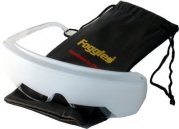After a couple of months of trying to get this arranged, I went flying with a pilot who owns a Grumman Tiger (to be more precise, an American General AG-5B Tiger). I had been a fan of the Tigers ever since I discovered they existed — from its cockpit to its shape to its performance, this seemed like a fantastic airplane worth checking out. I asked on Reddit for anyone willing to let me ride in one, and then saw Tiger parked at a repair shop. One bout of public-records stalking later and I had contacted the owner via Facebook and arranged a flight.

I met the pilot at the airport as she was finishing the preflight. She said she’d wanted to go over to Chino for fuel, and wanted to make it an instrument flight, so I’d act as her safety pilot. I was happy to oblige. With a flight plan pre-filed, we took off and she flipped on her foggles, though not before I got a chance to perform a climbing turn. It’s hard to tell from a few seconds with the yoke, but the plane seemed a bit more responsive than Pipers (my only other significant low-wing experience) though more stable than the Cessnas.

Apart from looking out of the airplanes for traffic, I spent my time just looking outside (the cockpit provides fantastic visibility while at the same time balancing it well with keeping things cool inside), asking questions about the instruments (there were a few strange decisions made by the original owner), and generally observing the flight. I’ve never been on an instrument flight (for what it’s worth, this was my second right-seat flight ever), and so a lot of the ways one conducts the flight were new to me. Having not had instrument training, I am not familiar with how to read approach plates or anything like that: vectors and altitudes and clearances are easy enough, but the details of how to execute the flight are not. There certainly seemed to be a lot of work required, and one needed to always be ahead of the airplane, knowing what they will tell you next and preparing for the next phase of flight. Surprisingly the pilot was pretty relaxed about it all, and though she was flying with foggles she was still able to chat with me, even before she got enabled the autopilot. I say surprisingly because I always assumed that instrument flight under the hood would take close to 100% of one’s concentration.
The flight overall went fairly smoothly. We got to Chino, filled up, and then flew pretty much directly back to Hawthorne (with a partially open cockpit, whee). In all, a pleasant flight with a friendly and very competent pilot in a fantastic plane.
Not loggable, but total: around 1.5 hrs in an American General Tiger.
 I think it’s been a full two years since I’ve worn a view-limiting device, so it was actually pretty challenging to transition into flying on instruments alone. The instructor gave me some heading changes, and we flew like that for a number of minutes. I think that this is probably one of the better aspects of the flight review: a low-pressure but forced instruction on a variety of topics you may be out of practice on.
I think it’s been a full two years since I’ve worn a view-limiting device, so it was actually pretty challenging to transition into flying on instruments alone. The instructor gave me some heading changes, and we flew like that for a number of minutes. I think that this is probably one of the better aspects of the flight review: a low-pressure but forced instruction on a variety of topics you may be out of practice on.